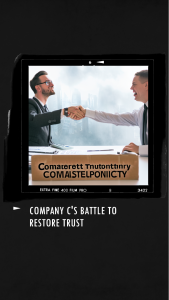In today’s hyper-connected digital landscape, where a single negative review can snowball into a full-blown PR crisis, companies must possess the finesse of a master artist to navigate these treacherous waters.
What is PR crisis management, and why is it important in the context of negative reviews?
PR crisis management involves strategies and actions taken by companies to mitigate and address damaging situations that could harm their reputation. Negative reviews can quickly escalate into PR crises due to their potential to spread virally online. To limit harm, rebuild trust, and transform a difficult circumstance into a chance for progress, effective crisis management is essential.
In this article, we explore the fascinating field of PR crisis management by looking at actual case studies of businesses that not only survived the onslaught of unfavorable press but also came out stronger and more resolute than ever.
However, some clever businesses have shown that even the toughest criticism can be turned into a chance for development and beneficial change with the appropriate techniques and mentality.
The Tycoon’s Turnaround: Company A’s Battle with Online Backlash

Company A, a prominent player in the retail sector, faced a severe PR crisis when an influential blogger’s scathing review of their flagship product went viral. The blog post ignited a firestorm of negative comments and widespread backlash on social media platforms.
Instead of succumbing to panic, Company A swiftly engaged in transparent communication. They acknowledged the issues highlighted in the review, publicly apologized, and demonstrated their commitment to rectifying the concerns.
By actively involving its customer base in the improvement process and providing regular updates, Company A transformed a potentially devastating situation into an opportunity to showcase its dedication to customer satisfaction.
The Tech Titan’s Triumph: Company B’s Battle Against a Digital Downpour

Company B, a technology giant, found itself in the midst of a PR crisis when a software glitch caused widespread frustration among its user base. Negative reviews flooded in, tarnishing the company’s reputation for innovation and reliability.
Company B addressed the criticism head-on rather than avoiding it. They quickly published a thorough description of the bug and a step-by-step tutorial for customers on how to lessen its impact.
Simultaneously, they mobilized their customer support teams to provide personalized assistance to affected users. Through a combination of transparency, empathy, and proactive solutions, Company B not only quelled the crisis but also demonstrated its commitment to its customers’ well-being.
The Hospitality Hero: Company C’s Battle to Restore Trust

In the hospitality sector, Company C faced a formidable challenge when a series of negative reviews highlighting subpar service went viral. With their reputation hanging by a thread, Company C took bold steps to regain customer trust.
They initiated an internal audit to identify and address the root causes of the issues raised in the reviews. Simultaneously, they launched a comprehensive staff training program aimed at enhancing customer interactions and service quality.
To communicate its dedication to improvement, Company C proactively engaged with its online audience, sharing progress updates and showcasing the tangible changes being implemented. Through an unwavering commitment to customer satisfaction, Company C managed to turn the tide of public opinion and reestablish itself as a beacon of exceptional service.
Conclusion
The art of PR crisis management is not merely about damage control; it’s about transforming adversity into opportunity and emerging stronger on the other side.
The case studies of Company A, Company B, and Company C exemplify the power of transparency, empathy, and proactive communication in navigating the tumultuous waters of negative reviews.
These companies not only weathered the storm but also emerged as beacons of resilience and customer-centricity.
As businesses continue to navigate the unpredictable landscape of online feedback, the lessons learned from these case studies serve as a testament to the transformative potential of effective PR crisis management.
FAQ’s
How do companies typically respond to negative reviews that could lead to a PR crisis?
Companies often respond to negative reviews by acknowledging the issues raised, expressing empathy, and offering solutions. Transparent communication, either publicly or privately, is key. Companies should avoid being defensive, engage in meaningful dialogue, and demonstrate a genuine commitment to resolving concerns.
Can you provide an example of a company that successfully managed a PR crisis stemming from negative reviews?
Certainly! Company B, a technology company, faced a PR crisis due to a software glitch causing widespread user dissatisfaction. They promptly released a detailed explanation of the issue, provided step-by-step guides for users, and offered personalized support. This proactive approach not only addressed the problem but also showcased their dedication to customer satisfaction.
How can companies leverage negative reviews as opportunities for improvement?
Negative reviews can offer valuable insights into areas that require improvement. Companies can analyze recurring themes in reviews, identify underlying issues, and implement necessary changes. By openly acknowledging these improvements and involving customers in the process, companies can showcase their commitment to growth and customer-centricity.
What role does transparency play in PR crisis management related to negative reviews?
Transparency is a cornerstone of effective PR crisis management. When companies are open and honest about the issues raised in negative reviews, it fosters trust among their customer base. Transparent communication includes admitting mistakes, providing clear information about the steps being taken to address concerns, and offering updates on progress.
How can companies rebuild trust and their reputation after a PR crisis stemming from negative reviews?
Rebuilding trust requires a multifaceted approach. Companies should take swift corrective action, communicate their commitment to change, and showcase tangible improvements resulting from customer feedback. Sharing success stories, implementing comprehensive training programs, and consistently delivering on promises can help companies regain trust and enhance their reputation over time.

